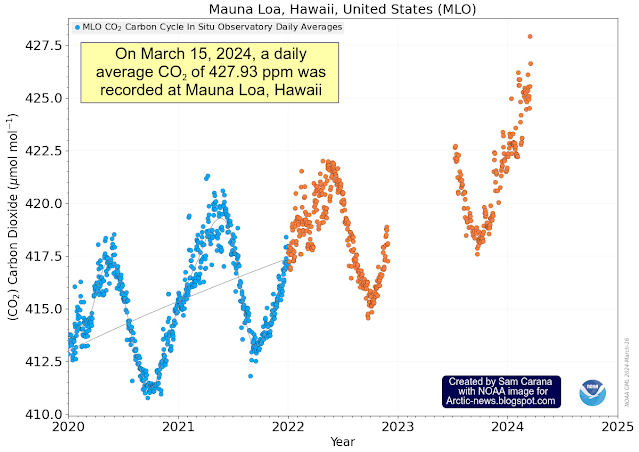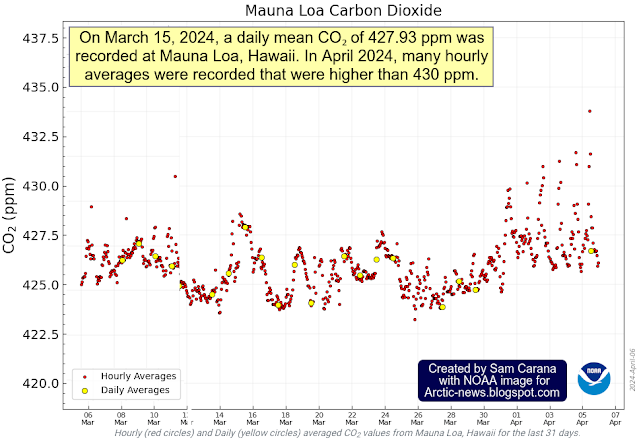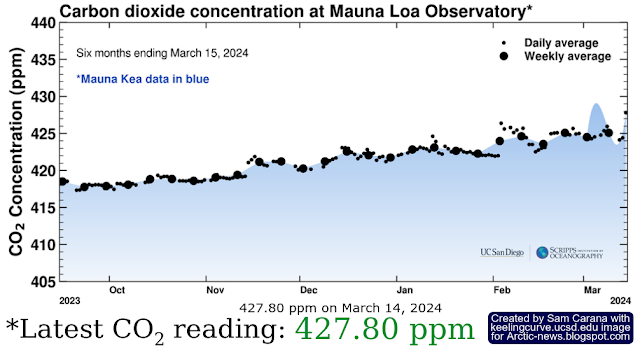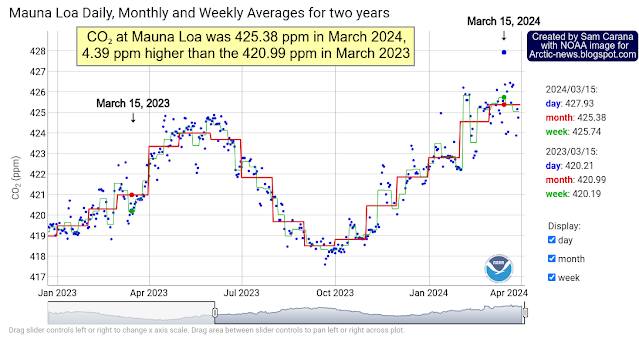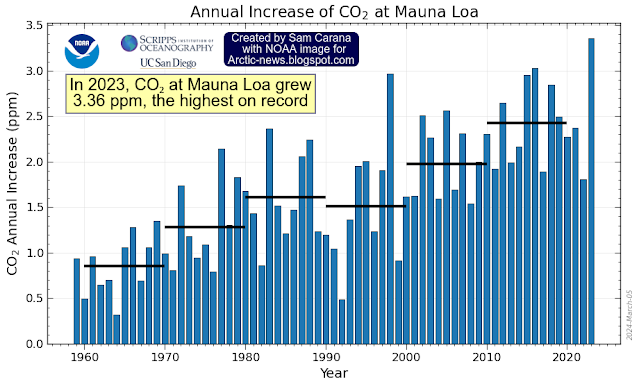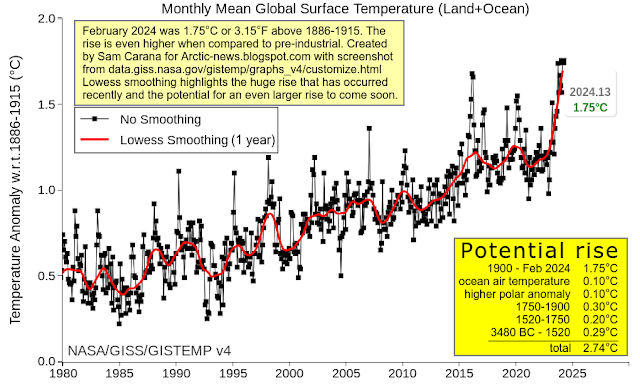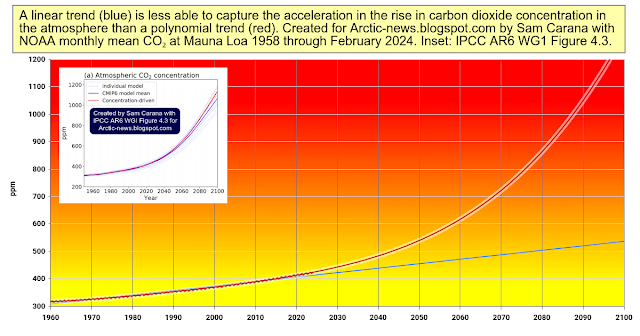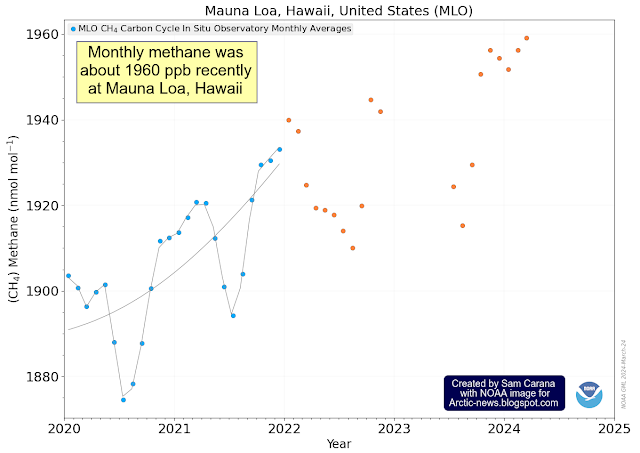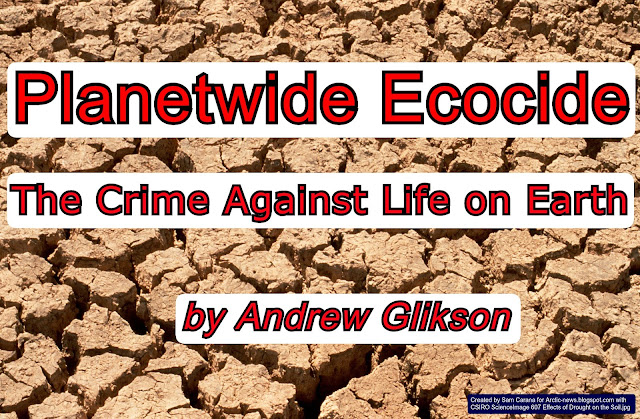On March 15, 2024, the daily average carbon dioxide (CO₂) at Mauna Loa, Hawaii, was 427.93 parts per million (ppm), as illustrated by the image below, adapted from NOAA.
This is the highest daily in situ average in the NOAA record at Mauna Loa, which is the more remarkable since the annual CO₂ maximum is typically reached in May, so even higher values are likely to be reached over the next few months.
The image below, adapted from NOAA, shows 31 days of CO₂ at Mauna Loa, Hawaii. The image shows that a daily mean CO₂ of 427.93 ppm was recorded on March 15, 2024, and that many of the hourly averages that were recorded in April 2024 were higher than 430 ppm.
The image below, adapted from the Scripps Institution of Oceanography, shows that CO₂ at Mauna Loa was 427.80 ppm on March 14, 2024. The background shows six months of CO₂ ending March 15, 2024.
The image below, adapted from NOAA, shows that the monthly mean CO₂ at Mauna Loa in March 2024 was 425.38 ppm, a growth of 4.39 ppm compared to March 2023.
The image below, adapted from NOAA, shows that the annual CO₂ growth at Mauna Loa in 2023 was 3.36 ppm, the highest annual growth on record.
Temperature rise
The February 2024 global surface temperature is 1.75°C or 3.15°F when compared to a base of 1886-1915, i.e. a 30-year period centered around the year 1900, as illustrated by the image below. The image shows part (from 1980) of a graph based on NASA Land+Ocean data from January 1880 through February 2024, with the black squares showing the raw monthly data.
Lowess smoothing (red line, 1 year window) highlights variability between years and the huge rise that has occurred recently, which is partly caused by variability such as associated with El Niño.
The red line also highlights the potential for an even larger rise to come soon, as feedbacks and further developments start to kick in with greater ferocity, contributing to non-linear and abrupt temperature rise, as discussed in earlier posts such as this one and this one.
The use of an early date for a pre-industrial base is discussed at the pre-industrial page and is supported by recent analysis of sponges collected in the Caribbean, illustrated by the image below.
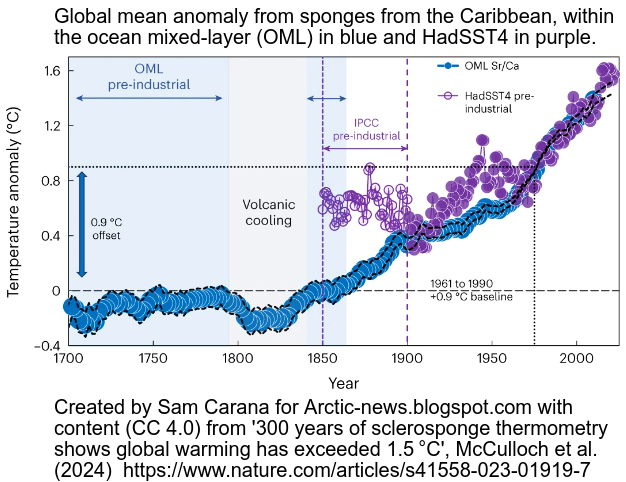 |
| [ from earlier post ] |
Other recent research debunks the idea that Earth’s surface (across land and sea) has experienced really hot temperatures over the last two billion years. Instead, it shows that Earth has had a relatively stable and mild climate. This makes the threat of a huge temperature rise over the next few years even more menacing.
The temperature is rising most rapidly in the Arctic. Loss of sea ice threatens to accelerate the temperature rise in the Arctic even more, and cause destabilization of methane hydrates at the bottom of the Arctic Ocean and thawing of permafrost on land, resulting in massive releases of greenhouse gases, further acceleration of the temperature rise and widespread extinction of species (including humans) as early as in the year 2026.
Clouds Tipping Point
The image below illustrates that a polynomial trend (red) can better capture the acceleration in the rise in CO₂ concentration in the atmosphere than a linear trend (blue).
Moreover, the clouds tipping point could be crossed much earlier when also taking into account methane. Monthly methane was about 1960 parts per billion (ppb) recently at Mauna Loa, Hawaii, as illustrated by the image below.
Furthermore, nitrous oxide is also rising and there are additional elements that could further speed up the temperatures rise, as discussed at the Extinction page, which shows that, altogether, there is the potential for a temperature rise of well over 18°C by 2026.
A 2018 study (by Strona & Bradshaw) indicates that most life on Earth will disappear with a 5°C rise. Humans, who depend for their survival on many other species, will likely go extinct with a 3°C rise, as illustrated by the image below, from an earlier post.
Environmental crimes
The accelerating growth in carbon dioxide indicates that politicians have failed and are failing to take adequate action.
Current laws punish people for the most trivial things, while leaving the largest crime one can imagine unpunished: planetary omnicide!
 |
| [ from earlier post ] |
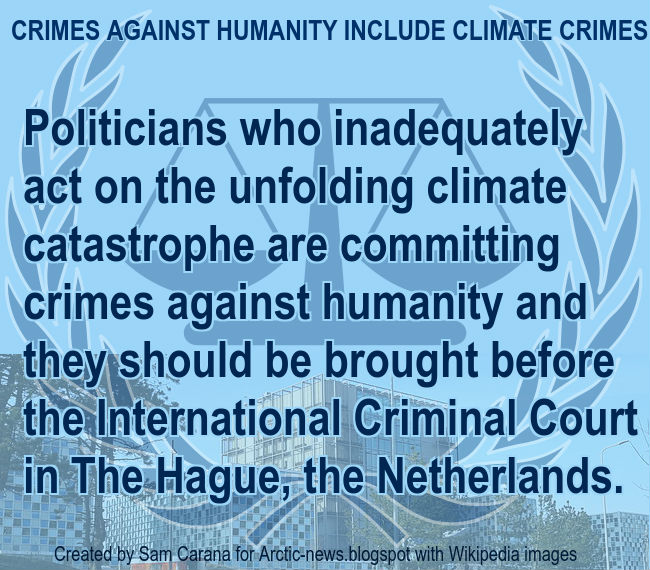 |
| [ image from earlier post ] |
Climate Emergency Declaration
The situation is dire and the precautionary principle calls for rapid, comprehensive and effective action to reduce the damage and to improve the situation, as described in this 2022 post, where needed in combination with a Climate Emergency Declaration, as discussed at this group.
Links
https://gml.noaa.gov/dv/iadv/graph.php?code=MLO&program=ccgg&type=ts
• Scripps Institution of Oceanography
https://keelingcurve.ucsd.edu
• NOAA – Weekly average CO2 at Mauna Loa
https://gml.noaa.gov/ccgg/trends/weekly.html
• NOAA – annual mean carbon dioxide growth rates for Mauna Loa
https://gml.noaa.gov/ccgg/trends/gr.html
• Planetwide Ecocide – The Crime Against Life on Earth, by Andrew Glikson
https://arctic-news.blogspot.com/2021/12/planetwide-ecocide-the-crime-against-life-on-earth.html
discussed on facebook at:
https://www.facebook.com/groups/climateplan/posts/8012665172096853
• ‘Revolutionary’: EU Parliament votes to criminalise most serious cases of ecosystem destruction
discussed on facebook at:
https://www.facebook.com/groups/climateplan/posts/7961500320546672
• How long do we have?
https://arctic-news.blogspot.com/2019/04/how-long-do-we-have.html
https://arctic-news.blogspot.com/2020/02/arctic-ocean-february-2020.html
• Co-extinctions annihilate planetary life during extreme environmental change, by Giovanni Strona and Corey Bradshaw (2018)
https://www.nature.com/articles/s41598-018-35068-1
• NASA GISTEMP – Temperature analysis Plots
https://data.giss.nasa.gov/gistemp/graphs_v4/customize.html
• Tragedy set to unfold in tropics
https://arctic-news.blogspot.com/2024/02/tragedy-set-to-unfold-in-tropics.html
• 300 years of sclerosponge thermometry shows global warming has exceeded 1.5 °C – by Malcolm McCulloch et al. (2024)
https://www.nature.com/articles/s41558-023-01919-7
• Oxygen isotope ensemble reveals Earth’s seawater, temperature, and carbon cycle history – by Terry Isson et al.
https://www.facebook.com/groups/arcticnews/posts/10161275962984679
• The Clouds Feedback and the Clouds Tipping Point
https://arctic-news.blogspot.com/p/clouds-feedback.html
• Feedbacks in the Arctic
https://arctic-news.blogspot.com/p/feedbacks.html
• Pre-industrial
https://arctic-news.blogspot.com/p/pre-industrial.html
• Extinction
https://arctic-news.blogspot.com/p/extinction.html
https://arctic-news.blogspot.com/2019/06/when-will-we-die.html
https://arctic-news.blogspot.com/p/climateplan.html
• Climate Emergency Declaration
https://arctic-news.blogspot.com/p/climate-emergency-declaration.html
